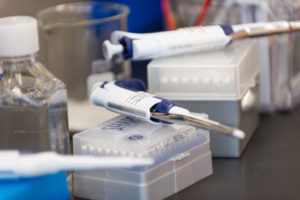Update: At a press conference on April 29, Colorado Gov. Jared Polis said the state is working on a partnership with CSU to run 45,000 tests on nursing home workers in May and June. He referred to this project as a “big priority.”

CSU Professor Greg Ebel has teamed up with Dr. Nicole Ehrhart, director of the Columbine Health Systems Center for Healthy Aging at CSU, on new research to minimize the chance that healthcare workers could unwittingly infect vulnerable residents in long-term care communities. Photo: CSU Photography
A team of researchers at Colorado State University is leading an effort to help the most vulnerable people in our communities – residents in long-term care communities – during the coronavirus pandemic.
Over the last two months, a lab run by Greg Ebel, professor in the Department of Microbiology, Immunology and Pathology, tested samples from 462 healthcare workers in Colorado to determine if workers without symptoms were silently carrying the virus. The tests identified 57 people who tested positive for COVID-19 but had no symptoms.
Ebel is partnering on this project with Dr. Nicole Ehrhart, director of the Columbine Health Systems Center for Healthy Aging at CSU.
Ehrhart introduced the concept for the groundbreaking project during a conference call with Colorado Gov. Jared Polis and state healthcare leaders, including Dr. Greg Gahm, a geriatrician and corporate medical director of Vivage, which owns a range of skilled nursing communities in Colorado and Missouri. Following the call, he tracked down Ehrhart and asked, “How can we work together?”
The purpose of the research, Ehrhart explained, is to enact an early warning system in long-term care facilities that would allow them to temporarily remove asymptomatic but COVID-19 positive caregivers from the workforce until they were no longer shedding the virus. This would minimize the chance that these workers could unwittingly infect vulnerable residents.
“The scientific community is putting their heads down, working around the clock, and sharing data across cultural belief systems and across borders that are closed right now. It’s an incredible moment of humanity and it’s the greatest interdisciplinary scientific effort that’s ever happened on Earth,” Ehrhart said.
Disease surveillance
The concept behind the research is a basic principle in disease surveillance, especially during a pandemic, said Ehrhart, a veterinarian and professor of surgical oncology at CSU.

“We don’t know when people become infectious with COVID-19,” she said. “It’s possible that they could be infectious prior to the onset of symptoms. It’s important that when there’s an at-risk community, like seniors, that we think about how to minimize the potential for transmission.”
Ehrhart said the team will sequence the virus genomes from these samples, which will provide information about how the virus is being spread. This will help them determine whether it’s due to a common source within the facility or if it’s being brought into the facility from the community.
Graduate student volunteers – trained and certified to transport pathogens – are serving as couriers, picking up swabs at facilities and delivering them to Ebel’s lab.
Gahm said that there are numerous reasons why his organization would like to know if asymptomatic workers test positive for COVID-19.
“It allows us to identify those people to say: you’re positive, even though you’ve been wearing a mask and following other safety protocols,” he said. “The Centers for Disease Control and Prevention and the health department is saying you need to go home at this time.”
Existing virus tracking methods
The tests being conducted in Ebel’s lab are similar in principle to the tests his team has used for West Nile virus surveillance in northern Colorado since 2014.
“We’re using equipment, approaches and efficiencies we developed from doing this type of work every summer, to try and protect the health of Fort Collins, Loveland and Berthoud residents from West Nile virus,” he said.
Ebel said what’s currently needed in response to the pandemic is a public health approach, and rapid testing.
“The crisis in test availability was bewildering,” he said. “A physician in a clinic wants an ironclad diagnosis. We provide something slightly different: rapid information on infection among people who aren’t showing symptoms.”
Ebel said the team first tests to see if there is any evidence at all that these healthcare workers have the RNA of the virus in a swab taken from the back of the nose.
“When we get a sample that is positive, we test it with two additional assays for confirmation,” he explained. “If an individual’s sample is positive using three different assays, there is very little doubt the person is infected with coronavirus.”
The Veterinary Diagnostic Lab at CSU – recently certified to conduct lab testing on human samples – is confirming the positive tests.
Helping the research community
Despite the trying times, Ebel says he’s in a perfect position to help scientists and the broader public health community learn more about COVID-19.
“For anybody who has been a virologist or infectious disease researcher, this is what we’ve been training for,” he said. “It feels good to do some small thing to help try and make things better.”
Ehrhart said that it’s been exciting to watch CSU’s scientific community collaborate in a way she’s never seen before.
“In order to do the screening tests, we need graduate students who have biosafety training to pick up test kits,” she said. “We are working with researchers who are computer modelers, because they are interested in looking at the data. All of these people are working as volunteers, and we see examples of this kind of collaboration happening all around the world.”
This research project is currently supported by startup funds through Ehrhart’s work at the Columbine Health Systems Center for Healthy Aging at CSU and Ebel’s lab. Additional support comes from the Office of the Vice President for Research at CSU, College of Health and Human Sciences, College of Natural Sciences, College of Veterinary Medicine and Biomedical Sciences and Walter Scott, Jr. College of Engineering.